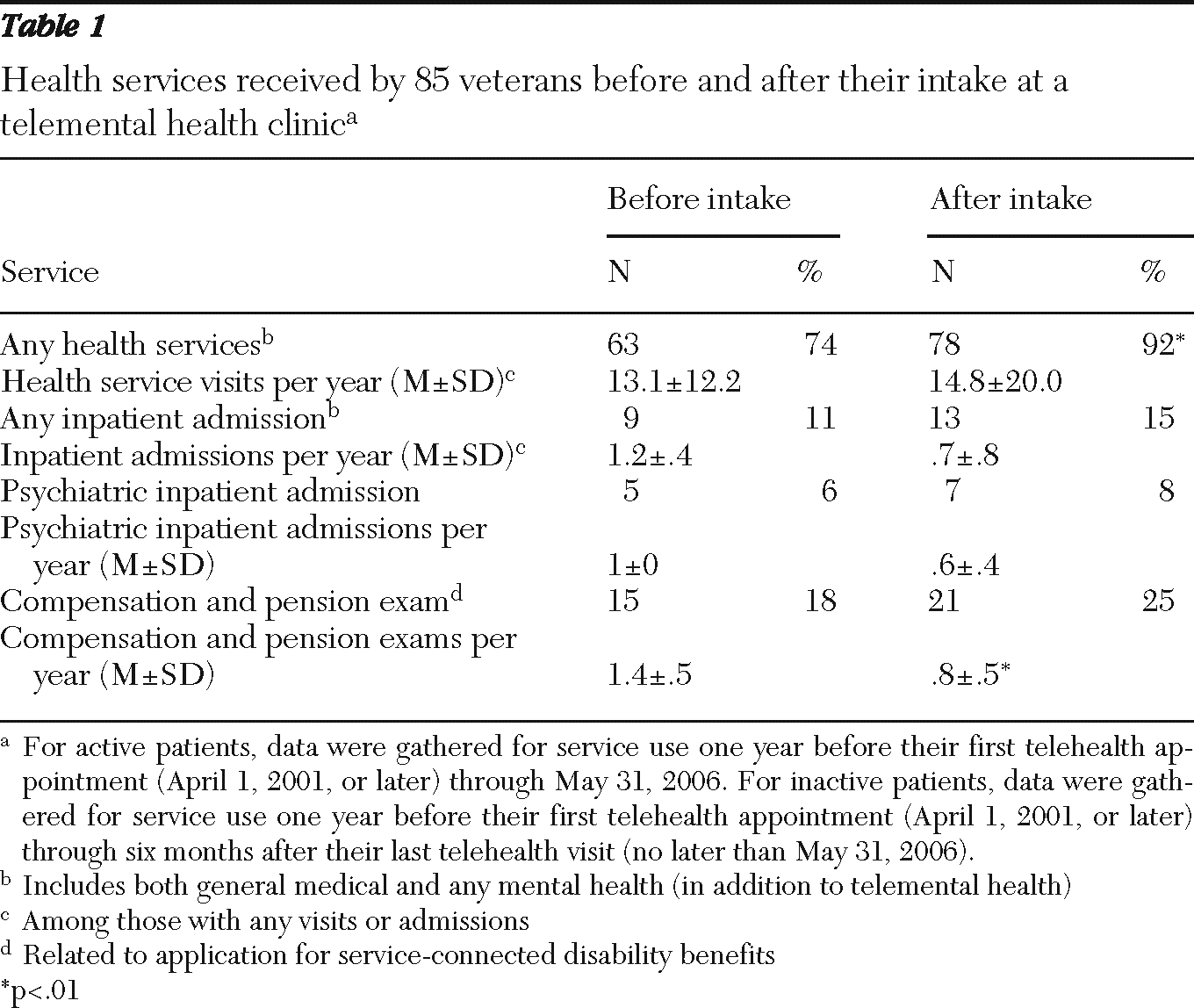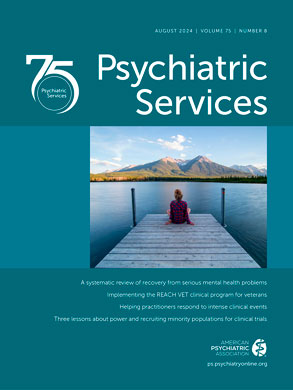American Indian and Alaska Native veterans have high rates of substance use disorders and posttraumatic stress disorder (PTSD) (
1,
2), have the greatest proportional representation of all males in the military, and have the highest proportion of rural residence of any veteran group (
3). Obtaining specialized treatment is a significant challenge for many American Indian and Alaska Native veterans (referred to here as Native veterans), particularly on reservations and trust lands, which are predominantly located in rural and isolated areas where the average household income falls well below the poverty line (
3). As in most rural areas, specialized health care is scarce and it is difficult to recruit physicians, especially those deemed “culturally competent” (
3).
Because of these complex health system issues for Native veterans, exploration of alternative models of service delivery, such as telemental health, is critical. Research has demonstrated the utility of telemental health in rural locations, underserved areas, and difficult-to-access populations; documented acceptable levels of patient and provider satisfaction; and validated telemental health-based standardized assessments (
4). Telehealth research on mental health treatment for veterans is more limited, although recent studies have examined telemental health services for American Indian veterans, addressing reliability of diagnoses, cost, and feasibility (
5,
6). Research and clinical programs that use telehealth services with Native groups are important, not only because they advance our understanding of best practices for rural veterans but also because they offer approaches to addressing rural health disparities.
A number of specialty clinics that provide telemental health-based care to treat PTSD among Native veterans living on or near reservation communities in the Central and Northern Plains offered an opportunity for such research. The purpose of this investigation was to describe characteristics—demographic, treatment, and service use—of patients utilizing these clinics and to better understand the impact of the telehealth clinics on patients' health care in the U.S. Department of Veterans Affairs (VA).
Methods
We reviewed medical charts for patients receiving services at two similar rural telemental health clinics for Native veterans. Approval was obtained from the Colorado Multiple Institutional Review Board and affiliated VA review boards where the study was conducted. Tribal communities' approval of the study was also obtained. The clinics involved operate under a unique partnership between the University of Colorado Denver's Centers for American Indian and Alaska Native Health, the VA (including the VA's Rural Health Resource Center-Western Region, the VA's Office of Telemedicine Services, and local VA medical centers), the Indian Health Service, and various tribal organizations. Partner roles and responsibilities for each clinic reflect the needs and circumstances of the particular community. In this model, described in detail elsewhere (
7), Denver-based clinicians provide care via videoconferencing to Native veterans at sites located in the patients' communities. The clinics utilize an outreach worker at the patient site, who is typically a veteran and a tribal member and who is responsible for administrative, technical, and tribal liaison functions.
We reviewed 85 charts of patients attending either of the two telemental health programs. To obtain patient data, we accessed the VA's electronic medical records system, which stores information for each veteran who seeks VA-based care. For active patients (patients utilizing services at the time of chart review), we gathered data on service use beginning one year before their first telehealth appointment (April 1, 2001, or later) through May 31, 2006. For inactive patients, we gathered service use data beginning one year before their first telehealth appointment (April 1, 2001, or later) through six months after their last telehealth visit (no later than May 31, 2006). Charts were reviewed for all patients enrolled in the clinics during this time period. Average time between telemental health intake and end date of data collection as described above was approximately three years (range of six months to five years).
Patient-level data collected through chart review were described with percentages, means, standard deviations, medians, and ranges. Statistical comparisons were made with chi square tests because dichotomous outcomes were compared. We used SAS, version 9.2, for all descriptive and inferential analyses (
8).
Results
All 85 patients were men. They ranged in age from 33 to 87 years (mean±SD age=58±9). Sixty (71%) had a service-related disability, and 41 (48%) were using services at the time of the review. The mean Global Assessment of Functioning (GAF) score was 45.7±15.3 (range 0 to 85). (Possible GAF scores range from 0 to 100, with higher scores indicating better functioning.) The men reported a range of environmental and social struggles, including social problems (N=53, 62%); problems with unemployment, work, and school (N=35, 41%); relationship and family problems (N=12, 14%); and financial and housing problems (N=9, 11%).
The 85 patients had a total of 1,631 telemental health clinic visits (mean per patient=19±25). After intake, 748 (46%) of the visits were follow-up visits with medication management, 547 (34%) were visits to attend a group, and 218 (13%) were follow-up without medication management. PTSD was the most commonly assessed problem at telemental health clinic visits, and it was highly comorbid with other diagnoses of active mental disorders. The proportion of veterans with comorbid PTSD in the various diagnostic subgroups— mood, anxiety, substance use, and other mental disorders—ranged from 75% (N=6) to 91% (N=32). On average, the patients had three to four active general medical diagnoses in addition to their diagnosis of at least one mental disorder. The most common general medical comorbidities were pain and cardiovascular and gastrointestinal disorders. [A table presenting data on rates of comorbid disorders in this sample is available as an online appendix at
ps.psychiatryonline.org.]
Information was also obtained from charts about any health services received by the patients, including mental health services independent of telemental health, before their first telemental health visit and between telemental health intake and the chart review (no later than May 31, 2006). The percentage of patients who received any health service increased significantly after telemental health intake (p<.01) (
Table 1). The number of patients who received a psychotropic medication significantly increased from 22 (26%) before telemental health intake to 60 (71%) after telemental health intake (p<.01).
Discussion
This is the first examination of service use by American Indian and Alaska Native veterans of telemental health clinics dedicated to this population. In this sample of veterans with mental disorders, the study found a strikingly high rate of comorbid general medical conditions and mental disorders, which is consistent with rates of comorbidities found in previous studies of American Indian veterans (
1,
2,
9). We observed a number of significant patterns as well as nonsignificant trends of increasing service use and treatment engagement at the two clinics. They included significant increases in prescription of psychotropic medications across drug classes and increases in antidepressant and hypnotic medications as recommended in the treatment guidelines for PTSD developed by the VA and the U.S. Department of Defense (
10). We also observed a nonsignificant trend toward lower rates of hospitalization among these patients and fewer hospitalizations per patient. We believe that this trend is an indication of better assessment, referral, and linkage to the larger VA system and resources.
Available national data on VA mental health treatment indicate that veterans with PTSD averaged 13.9 visits per year in 2005 (
11). For the two telemental health clinics, patients with a diagnosis of PTSD at the time of telemental health intake had an average of 9.5 mental health visits per year (including their telemental health visits) while they were active patients in the telemental health clinic. The trend of increasing service utilization in veteran populations has been previously described in a study of the impact of PTSD on veterans' use of general medical services in a sample drawn from the general population (
12).
This study has several limitations. Its major limitation is its descriptive nature; even though service use was examined before and after telemental health intake, no external control group was used. Given the uniqueness of these clinics, identification of appropriate patients for a control group or appropriate comparison populations is challenging. Also, retrospective chart reviews are inherently limited because such a design lacks prospective data, randomization, and the ability to examine specific patient-level clinical outcomes. Nevertheless, this work provides an important first look at the service characteristics of American Indian and Alaska Native veterans receiving treatment for PTSD in VA specialty clinics.
Conclusions
These findings contribute to the growing evidence supporting the use of specialty telemental health clinics for rural Native veterans. The evidence comprises data from diagnostic assessments and data on costs, acceptability, feasibility, and efficacy, as suggested in this study by the finding of increasing utilization of VA services (
5,
13,
14). Important next steps include further delineating these clinic models for refinement and dissemination, examining ways to better integrate and enhance coordination of treatment of general medical comorbidities in telemental health services, and exploring approaches to outcome studies that include comparison of similar services across non-Native populations. This expanding body of knowledge allows us to understand the impact of rural specialty telemental health clinics on patient care and the potential promise of this innovative mental health practice in Native communities. The results of this study will inform research and clinical strategies regarding cultural issues and outcomes related to telemental health services for this and other rural populations.
Acknowledgments and disclosures
This study was sponsored and funded by the Veterans Rural Health Resource Center-Western Region, Office of Rural Health, Department of Veterans Affairs, and the National Center on Minority Health and Health Disparities (application 1 P60 MD00507-01). The views expressed are those of the authors and do not necessarily reflect the position or policy of the Department of Veterans Affairs.
The authors report no competing interests.


